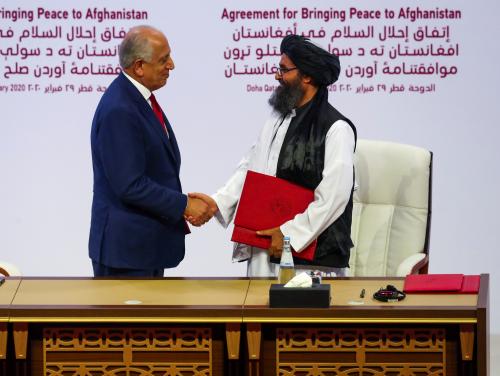One of the most pressing foreign policy decisions President Biden faces is what to do with the 2,500 U.S. troops remaining in Afghanistan. To date, he has not indicated the direction he’ll go.
A false step at this stage could essentially hand Afghanistan to the Taliban, which would risk massive repercussions, including the potential of a strengthened al-Qaida and a major setback for Afghan women’s rights and democracy. That would in turn reverse hard-won gains for a new generation of Afghans and at the same time seriously damage the credibility of a U.S. administration that champions these values.
Meanwhile, a growing chorus is framing Biden’s choice in one-dimensional terms: Should he withdraw all American troops from Afghanistan by May 2021, the date identified for a complete withdrawal in the U.S.-Taliban deal signed in Doha nearly a year ago? Or should he stay past that date? This flawed either/or narrative assumes that May 2021 is a unilateral deadline on the United States. But in fact, the Doha deal was signed by two parties, with conditions both have promised to fulfill. This black-and-white depiction presents a false choice.
A lopsided conversation
President Trump left his successor with a deal that was lopsided to begin with, negotiated in haste out of his desire to fulfill his campaign promise to end the war in Afghanistan. That haste and the lack of a path to a U.S. military victory yielded a deal that advantaged the Taliban, giving the insurgent group all that it wanted: a complete American withdrawal in return for a minimum in counterterror commitments. Trump then attempted to hobble his successor further by ignoring those very conditions the United States had placed on the Taliban. Despite evidence that the Taliban retains ties with al-Qaida and that al-Qaida remains in Afghanistan, Trump gave the order to unilaterally withdraw to 2,500 troops after his November election defeat.
Now many Afghanistan watchers in Washington and in the media have largely internalized the previous administration’s approach. They frame the deal as a deadline for America, placing the entire onus for the deal on us, with talk of an “extension” to stay past May — arguing that staying constitutes a violation of the deal. The narrative is deferential to the Taliban and the group’s proclaimed rigidities, yet at the same time harshly critical of the Afghan government’s dysfunction and corruption. Its proponents focus on the Taliban’s threats of violence if the United States stays beyond May.
All this exposes a crucial flaw in the Doha deal: Not only did we give away a lot for very little, we weren’t fully clear about our demands of the Taliban. The U.S. side originally thought giving some “gray area” in terms of conditions the Taliban had to meet (and rumored secret annexes to the deal) would be to America’s advantage by granting it flexibility. But that lack of clarity on Washington’s end, combined with the Taliban’s own discipline and clarity, has ossified the discussion into a lopsided one, and allowed the insurgent group to dictate terms and issue threats. I’m reminded of the Pakistani state’s attempted negotiations with the Pakistan Taliban during the group’s heyday in 2013-14. The insurgents came armed with a discipline that the Pakistani government could not match, and ended up commanding the narrative. (In the end, those “peace talks” failed in 2014, and the Pakistani military then mounted a successful operation against the Taliban — but Washington and Kabul cannot similarly take an exclusively military approach against the Afghan Taliban).
The Doha deal’s conditions on the Taliban
Let’s take a look at what the Doha deal does demand from the Taliban. The deal’s main counterterrorism condition on the Taliban sets out that “Afghan soil will not be used against the security of the United States or its allies,” and is detailed in Part 2 of the deal. It states that the Taliban “will send a clear message that those who pose a threat to the security of the United States and its allies have no place in Afghanistan, and will instruct members of the … Taliban not to cooperate with groups or individuals threatening the security of the United States and its allies.” It also says that the “Taliban will prevent any group or individual in Afghanistan from threatening the security of the United States and its allies, and will prevent them from recruiting, training, and fundraising and will not host them in accordance with the commitments in this agreement.” This is the part of the deal that is typically summarized as cutting ties with al-Qaida. It specifies that the Taliban cannot, among other things, host organizations like al-Qaida and must prevent them from operating in Afghanistan. The deal also says that the Taliban must take these steps “in conjunction with the announcement of this agreement.”
Yet as the U.S. Treasury noted last month, al-Qaida is “gaining strength in Afghanistan while continuing to operate with the Taliban under the Taliban’s protection.” It also stated that al-Qaida “capitalizes on its relationship with the Taliban through its network of mentors and advisers who are embedded with the Taliban, providing advice, guidance, and financial support.” This sounds precisely like a violation of Part 2 of the Doha deal. Perhaps the most direct acknowledgment of this so far from the Biden administration has come from the Pentagon press secretary, who noted that “the Taliban have not yet met their commitments.”
The right narrative on Afghanistan would highlight this dimension of the deal and its violations as much as the May 2021 date. I should be clear: I do not want the Doha deal to fail, flawed as it is, because it represents the best hope of a complete U.S. withdrawal from Afghanistan and a glimmer of hope for peace in the country. But we should be aiming for fulfilling commitments on both sides of the deal, not just America’s.
We should be aiming for fulfilling commitments on both sides of the deal, not just America’s.
The Biden administration and a “conditions-based” approach
The Biden administration’s first contact in Afghanistan came two days after the inauguration, when National Security Advisor Jake Sullivan called his Afghan counterpart Hamdullah Mohib and, according to a readout of the call, noted an intention to “review the February 2020 U.S.-Taliban agreement, including to assess whether the Taliban was living up to its commitment to cut ties with terrorist groups, to reduce violence in Afghanistan, and to engage in meaningful negotiations with the Afghan government and other stakeholders.” This implies the administration may be looking at conditions beyond “cutting ties with al-Qaida” to a reduction of violence and progress in peace talks.
This aligns with wording in the Doha deal that says that four parts of the deal are interrelated: the U.S. withdrawal, Taliban counterterrorism commitments, a lasting ceasefire, and a roadmap for the intra-Afghan deal, something Ambassador Zalmay Khalilzad also highlighted in congressional hearings last year. But because it is less explicit, that is harder to enforce than Part 2 alone. The conditionality of withdrawal on cutting ties with al-Qaida is most clearly outlined in the deal, and looking ahead, relying on that particular violation to enforce the “conditions-based” approach that Khalilzad is now stressing would stand the U.S. on the firmest ground.
Ultimately, as I’ve argued previously, the ideal approach for both America and Afghanistan would be to try and maintain troop presence to undergird the intra-Afghan peace process, but that is a decision that can be deferred further. The urgent thing for now is to turn the focus on the violation of our counterterror demands.
Changing the narrative
It is odd that refocusing the discussion around a conditions-based U.S. withdrawal from Afghanistan represents a change of narrative — after all, what deal is not conditions-based? And yet – in part because of the way the Trump administration largely ignored Taliban violations of the deal last year – talk of a conditions-based approach is seen as new. Instead, that should have been the understanding all along. The unhelpful framing of an “endless war” has also politicized the issue in the United States, such that any analysis outlining reasons to stay on beyond May 2021, including Taliban violations of the deal, is met with reflexive antagonism. This, despite our troops being at the same level as in Iraq and at cost levels that are sustainable (less than 3% of the U.S. defense budget).
Some of that politically charged antagonism is obviously borne out of the real risk that violence may increase or that we may have to increase our troop presence if we stay on past May — or both. There have been no U.S. troop casualties since last February, a significant achievement of the Doha deal that threatens to be lost if violence levels increase (it is worth remembering, though, that troop casualties had already decreased, to between 10 and 25 lives lost per year, for the five years before the U.S.-Taliban deal was signed). But those worries place short-term gains over long-term peace. The latter is more likely to be achieved if we enforce the deal as is, rather than as it has been misapplied and misinterpreted during the Trump administration.
We should be clear that there will be long-term costs to America and to the region if we withdraw unilaterally, without ensuring that the Taliban is meeting its own conditions. The Biden administration’s first decision on Afghanistan may also be the last opportunity it has to command the narrative, and to bring about a concerted change in how we view the deal: as one with obligations both sides have to fulfill. The new administration should make clear that so far, only the United States is meeting its commitments, and it should clearly specify again our expectations from the Taliban. The peace process set in motion a year ago, now in the phase of intra-Afghan negotiations, requires immense patience and care (and may still break down). For America to rush to the exits without ensuring the Taliban are holding up their side of the bargain is self-defeating.
The Brookings Institution is committed to quality, independence, and impact.
We are supported by a diverse array of funders. In line with our values and policies, each Brookings publication represents the sole views of its author(s).








Commentary
May 2021 should not be seen as a unilateral deadline for the United States to leave Afghanistan
February 10, 2021